管内肠─用核磁共振成像连续测量异质样品中细胞群间的代谢串扰
IF 6.7
1区 化学
Q1 CHEMISTRY, ANALYTICAL
引用次数: 0
摘要
在复杂的生命系统中,如人类肠道,多种细胞类型之间的相互作用是由小分子代谢物的交换控制的。然而,目前,我们缺乏能够实时和空间分辨率地监测这种串扰的技术。在这里,我们提出了一个5毫米核磁共振管中的人类肠道模型,该模型考虑了腔内、粘膜和结肠菌空间。细胞在不同的空间区域培养,使代谢物、pH值变化和外源分子的影响能够使用局部核磁共振技术进行专门监测。我们的模型代表了一种在分子水平上研究具有多种细胞类型的生命系统的高通量,易于获得且广泛适用的方法。我们使用我们的模型来探索人类大肠中肠道细菌和结肠炎细胞之间的相互作用,并研究这些系统中自然存在的分子浓度梯度。这些研究有助于阐明肠道微生物群在维持肠道稳态、调节免疫反应、代谢营养物质和调节宿主生理方面所起的关键作用。本文章由计算机程序翻译,如有差异,请以英文原文为准。

Gut in Tube─Continuous Measurement of Metabolic Crosstalk between Cell Populations in Heterogeneous Samples by NMR Imaging
In complex living systems, such as the human gut, the interplay between the multiple cell types present is governed by the exchange of small molecule metabolites. However, at present, we lack techniques capable of monitoring this crosstalk in real time and with spatial resolution. Here, we present a model of the human gut in a 5 mm NMR tube that accounts for the intraluminal, mucosal, and colonocyte spaces. Cells are cultured in different spatial regions enabling metabolites, changes in pH, and the effects of exogenous molecules to be monitored exclusively using localized NMR techniques. Our model represents a high-throughput, readily available, and widely applicable approach to the study of living systems with multiple cell types on a molecular level. We used our model to explore the interplay between gut bacteria and colonocytes in the human large intestine and study the molecular concentration gradients naturally present in these systems. Such studies could help shed light on the crucial role played by the gut microbiota in maintaining gut homeostasis, modulating immune responses, metabolizing nutrients, and regulating host physiology.
求助全文
通过发布文献求助,成功后即可免费获取论文全文。
去求助
来源期刊

Analytical Chemistry
化学-分析化学
CiteScore
12.10
自引率
12.20%
发文量
1949
审稿时长
1.4 months
期刊介绍:
Analytical Chemistry, a peer-reviewed research journal, focuses on disseminating new and original knowledge across all branches of analytical chemistry. Fundamental articles may explore general principles of chemical measurement science and need not directly address existing or potential analytical methodology. They can be entirely theoretical or report experimental results. Contributions may cover various phases of analytical operations, including sampling, bioanalysis, electrochemistry, mass spectrometry, microscale and nanoscale systems, environmental analysis, separations, spectroscopy, chemical reactions and selectivity, instrumentation, imaging, surface analysis, and data processing. Papers discussing known analytical methods should present a significant, original application of the method, a notable improvement, or results on an important analyte.
 求助内容:
求助内容: 应助结果提醒方式:
应助结果提醒方式:


